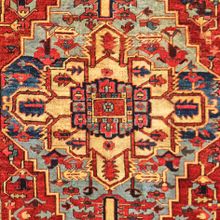Bakhshaish Rug
| Bakhshaish Rug | |
|---|---|
 Design of Bakhshaish Rug (Rugman) | |
| General information | |
| Name | Bakhshaish Rug |
| Original name | قالی بخشایش |
| Alternative name(s) | Bakhshaish Carpet |
| Origin | |
| Category | Village |
| Technical information | |
| Common designs | Medallion, Herati, Geometric |
| Common colors | Blue, Red, Beige, Camel |
| Dyeing method | Natural, synthetic |
| Pile material | Wool |
| Foundation material | Cotton, Wool |
| Knot type | Symmetrical (Turkish) |
Bakhshaish Rug originate from Bakhshaish, a small village in the Province of Azerbaijan, has an excellent reputation for traditional rug weaving. Located in northwestern Iran, the traditional rug weavers in Bakhshaish have been strongly influenced by their neighbors in Heriz. Although the patterns and styles are very similar to the rugs produced in Heriz, the distinguishing difference is that the color scheme on a Bakhshaish traditional rug features rich colors such as navy blue or red which are often highlighted with amazing color, while in Heriz the geometric medallion is set on a lighter colored field. Bakhshaish rugs are woven using coarse Turkish knots. This tight knotting process makes it extremely durable.
History
Bakshaish, also spelled Bakshayesh, is a town in the East Azerbaijan Province of northwestern Iran. In the nineteenth century it was a weaving village populated by the Azeri tribe who speak in a Turkic dialect. Bakshaish rugs and carpets are known in the market from the mid-nineteenth century. Many carpets have a cotton foundation and a wool pile, but in early pieces, Bakshaishes can have a wool foundation or a cotton warp with a wool weft. The Turkish (symmetric) knot is universally used. The nineteenth-century Bakshaish carpet designs are geometric with either an allover or medallion style. Popular traditional floral designs were adapted into geometric and tribal patterns by Bakshaish weavers for their carpets.
Notable Bakshaish designs were the Herati (fish), Lattice, Minakhani (rosette-linked trellis), Open Field with medallion, large palmettes, Shrub, Tree of Life, and willow tree. These styles attracted the attention of Western markets and were com-missioned by European importers with the addition of some primitive designs. In some Bakshaish carpets, nomadic motifs such as the Star, flower heads, S motif, animals, birds, and human figures, among others, are found in the field and borders.
Some early Bakshaish room sizes have the famous Dragon motif woven in the medallion and corners of the carpet. During the nineteenth century poetic inscriptions occasionally were woven in the borders of Bakshaish carpets. The inclusion of poems in carpets was popular at the time, but the woven inscriptions cannot be read clearly because village weavers were unable to transfer the words properly. On rare occasion, charming scenic designs can be found in smaller Bakshaish weavings. Today they are collectible and bring high prices in the open market.
Some early Bakshaishes have only a narrow guard border to frame the carpet. At times, a row of trefoil motifs may form the inner and/or outer border of the carpet. Bakshaish carpets are categorized in the Heriz rug group. By the early twentieth century Bakshaish weavers switched their designs to Heriz styles because of market demand and continue to follow this design today. Silk pile weavings have been attributed to Bakshaish in the antique trade, but it is more likely that these rugs were produced in the nearby village of Heriz.
Bakshaishes are famous for having a diverse range of colors for the background, especially lighter tone colorations such as beige, ivory, light greens, light blues, gold, and camel, along with rust-red and dark blues. This was a very important and positive change for Persian weavings in the nineteenth century. In addition to these colors, different shades of red, blue, green, cinnamon, gray, gold, and brown appear in the medallion, borders, and design elements. Dark brown or black is woven for the design outlines.
The formats range from small mats to oversize rugs, occasionally in squarish dimensions. At times, runners and gallery formats were woven.The carpets are made from good to fine in grade quality.
Bakshaish weavers are credited with innovating numerous creative and beautiful design elements in the nineteenth century. It was rare that village weavers were producing such a wide variety of tribal patterns and colorations in this era. These carpets are valuable and are appreciated by designers and consumers. Early Bakshaish carpets command very high prices in the antique trade.[1]
See also
| Search for Bakhshaish Rug on Wikipedia. |
References
- ↑ Moheban, 2015, 86-88
Bibliography
- Abraham Levi Moheban. 2015. The Encyclopedia of Antique Carpets: Twenty-Five Centuries of Weaving. NewYork: Princeton Architectural Press.